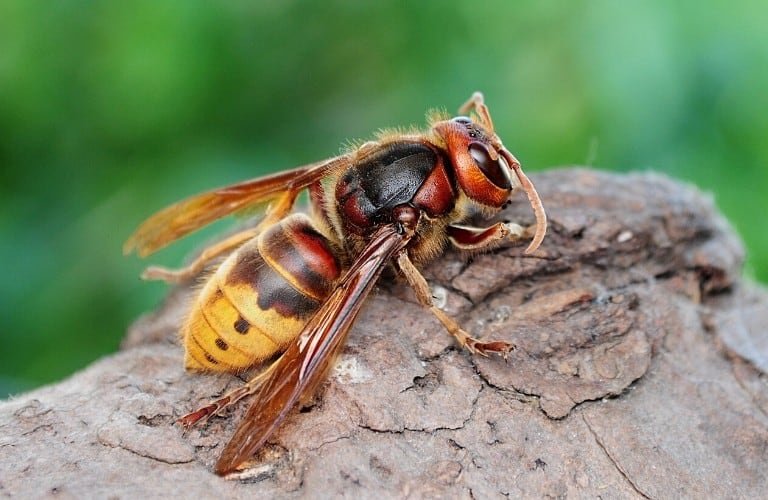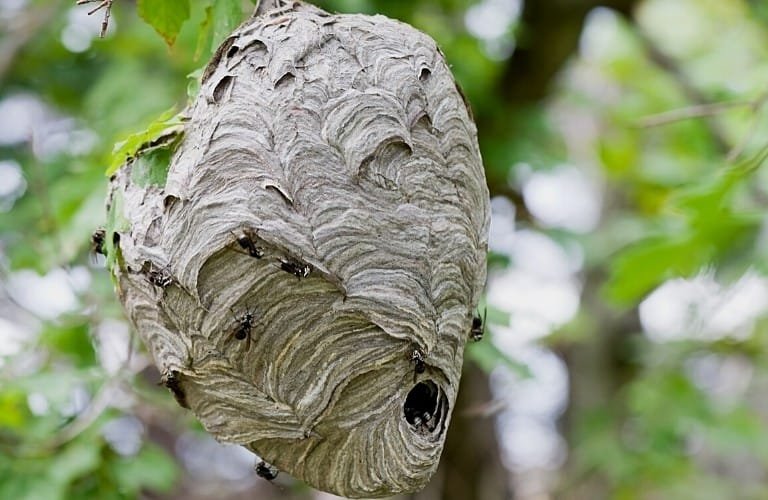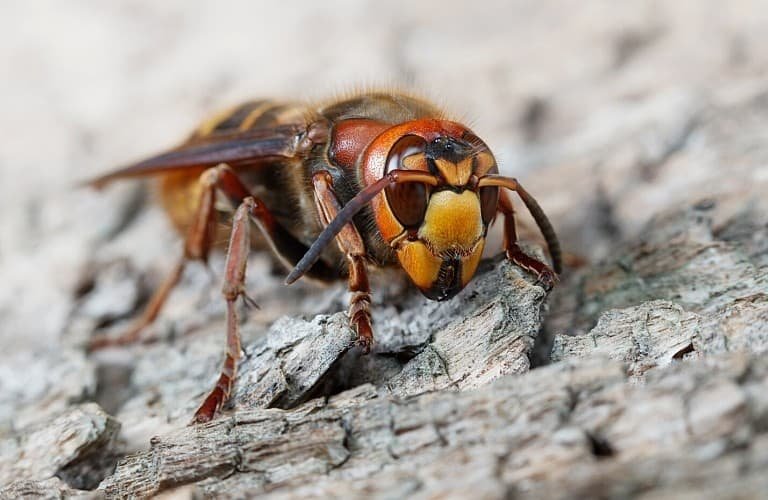Being afraid of hornets is completely natural as they will attack if you get too close or disturb their nest.
Their stings are painful, so you’ll of course want to clear your yard of all hornets to keep your family safe.
How do you get rid of a hornet’s nest? Homemade traps with vinegar, meat, or sugar water as bait can be used to catch hornets before removing the nest after dark. Place nest in freezer to kill remaining hornets. Sticky traps, natural sprays, wasp traps, and pesticide sprays, dust, and foam will eliminate hornets too.
Hornets die in the winter, so you can always wait for them to vanish on their own.
However, if you don’t want to wait until then, we’ll outline prevention tips and explain what you can do now to rid your home and yard of hornets.
Identifying Hornets and Hornet Nests
Wasps, hornets, and yellow jackets are all similar and commonly confused with each other.
Hornets are a type of wasp, as are yellow jackets. Hornets are one of the largest species of wasp, measuring 1-2 inches in length.
Some hornets are black and white, but others are black and yellow. The yellow portion can range from a gold to an orange color.
Hornets are social creatures, so they live together in a nest and attack in groups to protect the nest. Only the female hornets have stingers.
Hornet nests look a bit like a paper mache project, and that’s because hornets take wood from nearby sources and chew it up into a pulp to build their nests.
The wood they use can come from trees, fences, house siding, and anything else made of natural wood.
The inside has several little cells in which eggs are laid, but the hornets cover them up to protect them.
There’s usually one hole for hornets to go in and out of, but larger nests may have a few entry points.
Wondering if those nests are full of yummy honey? Find the answer here.
Commonly Mistaken Pests
Yellow jackets and wasps are black and yellow or brown and yellow, but they are smaller in size than hornets.
Yellow Jacket
Yellow jackets have black and yellow bands similar to those of a wasp, but their antennae are black.
Unlike wasps, however, yellow jackets usually construct their nests underground and fly with their legs held close to the body.
Vesper Wasp
Vesper, or paper, wasps can be identified by their orange-tipped antennae. During flight, their legs dangle freely.
Paper wasp nests can often be found on porches, under eaves, and on other man-made structures.
If you have lots of questions about these stinging pests, you’re not alone. We answer the most common questions about hornets here.
Removal Methods
| Method | Cost | Natural | Odor Free |
| Natural aerosol spray | $20 | ✅ | |
| Sticky trap | $20 | ✅ | ✅ |
| Bug zapper | $40 | ✅ | ✅ |
| Apple cider vinegar | $10 | ✅ | |
| Suncatcher | $15 | ✅ | ✅ |
| Hornet trap | $18 | ✅ | |
| Aerosol spray | $7 | ||
| Insecticide dust | $35 | ✅ | |
| Foam spray | $15 | ✅ |
The Best Way to Eliminate a Hornet Nest
There are a few “best” ways to eliminate hornet nests based on which approach you’d like to take.
Handling hornet nests is dangerous and requires working quickly, so you shouldn’t try to do anything that makes you too uncomfortable to get the job done.
For the Brave
You will need:
- Protective clothing.
- Flashlight.
- Trash bag.
- Freezer.
To get rid of the nest:
- Wait until the coolest part of the night.
- Wear a beekeeping suit or several layers of clothing.
- Working quickly, place a trash bag around the nest and tie it. If it’s on a tree, you may need to trim the limb first so the bag will fit. If it’s on a house, pull the bag strings tightly to cause the nest to disconnect from the house.
- Remove the nest by cutting the limb of the tree. Step three should have removed it from a house.
- Place the closed bag in the freezer overnight to kill the hornets.
This method is very dangerous. Hornets can’t see well in the dark, so avoid shining flashlights directly at them.
They’ll have more difficulty stinging you if they can’t see.
For Those With Patience
You will need:
- A 2-liter bottle.
- Apple cider vinegar.
- Water.
- String.
- Tape.
- Raw meat or sugar.
- Dish soap.
- Scissors/hobby knife.
This focuses on eliminating hornets rather than the nest. To make the trap:
- Remove the lid of a 2-liter bottle, and cut around it toward the top. Turn the funnel you created upside down and secure it in place with tape. Make two holes for string.
- Pour in some water and apple cider vinegar. Add a piece of raw meat to attract wasps. You can also use sugar water if you don’t want to use meat. Add a drop of dish soap.
- Pull string through the holes, and tie it so you can hang the trap.
- Hang the trap near a hornet’s nest. Be careful when placing it.
You’ll need to replace the trap when it’s full of hornets.
Keep in mind that this won’t kill the entire colony unless it kills the queen, but the queen probably won’t come out of the nest.
If you usually get hornet nests, in the spring place this trap in areas where nests are usually built.
You’ll have a chance of trapping and killing the queen before she’s able to build her nest.
For the Cautious
If you have any reservations about getting rid of a hornet’s nest, calling an exterminator is the safest way to go.
They’ll use pesticides that are toxic to the environment, people, and animals, but professionals will know the safest way to apply them.
Pesticides are always a risk, but hornet stings can be lethal if you have an allergic reaction to them.
Basic Guidelines
There are a few things you can do all year long to prevent hornets from building nests around your home in the spring.
Keep Plants Away From Your House
Hornets pollinate flowers just as bees do, though not nearly as effectively.
If you have flowering plants near your house, hornets will want to build their nest nearby so they can have easy access to food.
If hornets are a recurring issue around your home, try planting flowers away from the house to discourage them from nesting too close.
Keep Garbage Cans Clean
Hornets will also go after food in trash cans, so be sure to keep them clean.
Tie up all trash bags before putting them in the cans, and keep the can lids sealed shut.
If trash spills out of a bag and into the can, give it a wash with the water hose and let it air dry.
Make cleaning the cans a routine so you won’t have to worry about attracting hornets and other insects to your yard.
Don’t Wear Perfume Outside
According to a study, it appears that an ingredient used in perfume has the same smell as hornets.
Remember that hornets are territorial creatures, so when they smell other hornets, their first instinct is to attack.
That means that if they smell perfume on someone, they’re probably going to sting the person wearing it and maybe others who are nearby.
If you’re going to spend any time outdoors, consider leaving the perfume at home.
Natural Solutions to Get Rid of Hornet Nest
Pesticides are admittedly the easiest way to get rid of hornets without getting stung, but these pesticides can introduce several health and environmental concerns.
Luckily there are several natural solutions you can use to get prevent, trap, and get rid of hornets.
Indoor Infestations
Any hornet problems you have indoors will probably be the occasional stray one that gets inside. Here are a few solutions for the lost wanderers.
Natural Aerosol Spray
For the few stray hornets that find their way into your home, a natural aerosol spray is one of the safest ways to kill it.
EcoSMART Organic Wasp and Hornet Killer uses peppermint oil to kill the hornets.
Peppermint oil is naturally toxic to many insects and will kill hornets on contact. You can also use EcoSMART outdoors and on hornet nests.
Since this product is oil based, it may stain some surfaces. You may want to spot test on indoor surfaces.
If it gets on plants, rinse or wipe off the leaves. EcoSMART is safe to use around children and pets unless anyone is allergic to the ingredients.
Sticky Traps
Sticky traps are a great way to catch hornets that found their way inside.
RESCUE! Non-Toxic TrapStik will trap hornets and other insects with its sticky surface.
It doesn’t use chemicals to attract them – only the colorful design.
Hang the trap near where you usually see the hornets buzzing around in your home. You can also hang it outside to prevent them from coming in.
If you see that the hornets have a hard time finding the trap, try placing some bait, like sugar or perfume, on the bottom portion.
Don’t cover the entire surface or it will lose its stickiness.
Bug Zapper
Bug zappers attract hornets with light and use electricity to kill them.
The Klahaite Bug Zapper can be set on a table or hung from the ceiling and will work well inside and outside.
You’ll hear the sound of hornets getting zapped, so it may be uncomfortable for some people.
You can also place bait near this trap as well. The trap has a bottom that you could place the bait in.
Just be sure the bait isn’t too liquidy, and be sure to keep it away from the light.
Outdoor Infestations
Outdoor infestations are the main problem when it comes to hornets.
Here are a few things you can do to decrease the population buzzing around your home.
Vinegar Trap
Bragg Organic Apple Cider Vinegar can be used in a DIY trap to collect the curious hornets that find their way inside.
You can use a 2-liter bottle or a small bucket to make the trap. Instructions are listed above.
The vinegar is part of what attracts the hornets to the trap and helps kill them. The dish soap will trap the hornets in the water and cause them to drown.
These traps will smell bad after a while, so you’ll need to change them frequently.
Suncatcher
Suncatchers are beautiful decorations that cast rainbows all over when the sun hits it.
The beams of light irritate hornets and will make them not want to stay in the area.
Hang up a suncatcher like the Pedobo Crystal Ball Prism Suncatcher near your house or in a tree in early spring to prevent queen hornets from claiming their territory.
You may want to hang up a few in different places around your yard to cover a larger area.
Since the Pedobo suncatcher is made of glass, you may want to take it down on windy days or during thunderstorms.
Hornet Trap
The RESCUE! WHY Hanging Outdoor Trap uses attractants to draw in hornets.
They crawl into the trap through the bottom but won’t be able to get out. They’ll die naturally once they’re stuck inside.
This trap is reusable, so once all the hornets have died, you can empty it out, add a new attractant cartridge, and continue to use it.
Hang the trap in areas where you see hornets, whether it’s near the nest or by flowers.
As we mentioned before, this kind of trap may not get rid of the entire colony, but it will at least cut down the amount of hornets buzzing around and scaring the children.
Pesticide Solutions to Get Rid of a Hornet Nest
Pesticides are toxic for everyone, but they do allow for instant removal of hornets.
Here are some options you have when it comes to hornet removal.
| Preview | Product | Rating | |
|---|---|---|---|

|
Spectracide Wasp & Hornet Killer Spray, Kills... | Check Price on Amazon | |

|
BioAdvanced Termite and Carpenter Bee Killer Plus,... | Check Price on Amazon |
Aerosol Spray
Aerosol spray is a quick way to kill all the hornets in a nest.
Spectracide Wasp & Hornet Killer has a spray stream that can reach up to 27 feet, so you’ll be able to keep a safe distance from the nest when using this product.
You’ll need to protect your face and arms and keep everyone away from the area since the wind may cause the spray to spread pretty far.
This product is best used on a day that there isn’t any wind.
Insecticide Dust
Insecticide dust is another quick way to get rid of hornets in the nest, but it requires you to be right at the nest, which can make it a dangerous process.
However, as you squirt out the dust, it spreads all throughout the nest and will kill at least a majority of the hornets.
Delta Dust Insecticide Dust is used for many insects and it works well for hornets.
Be sure to cover your face, and wear gloves and several layers of clothing because you’re bound to upset a few hornets.
Foam Spray
Foam spray is sort of a cross between aerosol spray and insecticide dust. It sprays out and expands once applied.
When you spray it inside the nest, it’ll cover up most of the area and will suffocate the hornets in chemicals.
BioAdvanced Termite & Carpenter Bee Killer is a good option because it comes with a tube sprayer that will give you a little bit of space between yourself and the nest.
It will be sure to cover all the hard to reach areas that you can’t see from outside of the nest.
For a more complete list of sprays for killing hornets, visit our article here to learn which are the most effective and explore all-natural pesticide sprays as well.
Safety Precautions When Using Pesticides
The toxic chemicals that kill hornets are capable of harming anything else that comes into contact with them.
Never apply pesticides around children or pets.
Always alert everyone in the area that you’re applying pesticides, especially since hornet nests are high enough that the wind can easily carry chemicals elsewhere.
Be sure to protect your eyes, nose, and mouth, and wear several layers of clothing.
The layers aren’t just to keep toxins off your skin but to keep your skin safe from hornet stingers since they’ll be ready to attack you while you try to kill them.
When to Call a Professional Exterminator
Call an exterminator if you feel unsafe around hornet nests or if you’re unsure of your ability to go through with removing them.
Hornets release more venom than bees, so stings are quite painful, and anyone who’s allergic to the hornet’s venom may experience severe or lethal reactions.
Professional exterminators are equipped to remove them safely and prevent anyone from getting hurt.
Before you make the appointment, be sure that you’ve read through all of our hornet articles and are aware of the many DIY hornet removal options that could save you the cost of hiring a professional.
Frequently Asked Questions
When Can You Remove a Hornet’s Nest?
You can safely remove a hornet’s nest at the end of fall or in the winter when the nest is empty.
If you wait until this time, you won’t have to worry about getting stung.
If you don’t want to wait until then, wait until it’s dark and cool at night to slip a bag over the nest, tie it, and cut off the tree branch.
Placing the bag in the freezer for the night will kill all the hornets inside.
If you do this, wear several layers to protect yourself since you’re risking getting stung.
Do Hornets Come Back to the Same Nest?
Hornets never return to their nests or reuse other nests.
The nests are built annually when it’s warm and are emptied out once it freezes for the first time at the end of fall.
When it’s time for the queen to start a new colony when it’s warm again, she’ll find a new location to build the nest.
Do Hornets Die in the Winter?
Hornets die in the winter because they can’t survive cold temperatures.
The queen will hibernate by hiding in a crevice or a hole in the ground and will emerge in the spring to start a new colony.
Hornets are territorial and won’t build a nest near others, so you may want to consider leaving them there as a form of prevention.
Source:
https://www.baltimoresun.com/news/bs-xpm-2003-08-07-0308070146-story.html











